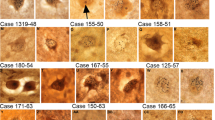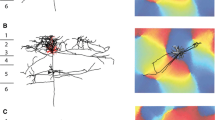Summary
With the aid of a newly developed technique for the successive examination of both the Golgi and pigment picture of individual neurons (Braak, 1974a) Braak (1974b) demonstrated that within lamina II and upper lamina III of the human isocortex, heavily pigmented non-pyramidal cells are distributed irregularly and sparsely. The lipofuscin pigment granules serve as excellent internal markers to identify these non-pyramidal cells in ultrathin sections. This favourable circumstance facilitates the study of these interneurons in the electron microscope.
The heavily pigmented non-pyramidal cells are small, spherical to ovoid with diameters of about 12–15 μm. One pole of the cell comprising a large cytoplasmic area gives rise to a few dendrites, while the other pole is occupied by the nucleus and in some cases is in close apposition to another nerve cell body. The nucleus is deeply invaginated by the large cytoplasmic area and occasionally displays nuclear inclusions. Among the usual organelles distributed within the large cytoplasmic area the mitochondria with a moderately electron dense matrix are abundant and the coarse lipofuscin pigment granules are the most striking elements. The latter contain densely packed filamentous or tubular material and a single vacuole. The perikaryon rarely receives more than 3 type I and type II synapses per section per cell, whereas the dendrites receive numerous synapses of both type I and type II. Within the apposition zone to another nerve cell body (which in no case is a heavily pigmented non-pyramidal cell) puncta adhaerentia occur and also contacts in which the cleft of 8 nm is intersected by a dense stratum.
Some of the ultrastructural findings are summarized in the schematic drawing of Figure 15.
Similar content being viewed by others
References
Blinzinger, K., Rewcastle, N.B., Hager, H.: Observations on prismatic-type mitochondria within astrocytes of the Syrian hamster brain. J. Cell Biol. 25, 293–303 (1965)
Braak, E.: On the fine structure of the external glial layer of the isocortex of man. Cell Tiss. Res. 157, 367–390 (1975)
Braak, H.: On the structure of the human archicortex: I. Cornu ammonis. A Golgi and pigmentarchitectonic study. Cell Tiss. Res. 152, 349–383 (1974a)
Braak, H.: On pigment-loaded stellate cells within layer II and III of the human isocortex. Cell Tiss. Res. 155, 91–104 (1974b)
Cammermeyer, J.: An evaluation of the significance of the “dark” neuron. Ergebn. Anat. Entwickl.-Gesch. 36, 1–61 (1962)
Chandler, R.L.: An intranuclear fibrillar lattice in neurons. J. Cell Sci. 1, 283–286 (1966)
Colonnier, M.: Synaptic patterns on different cell types in different laminae of the cat visual cortex. An electron microscope study. Brain Res. 9, 268–287 (1968)
Duncan, D., Morales, R.: Fine structure of astrocyte mitochondria in the spinal cord of the dog, cat and monkey. Anat. Rec. 175, 519–528 (1973)
Garey, L.J.: A light and electron microscopic study of the visual cortex of the cat and monkey. Proc. roy. Soc. B 179, 21–40 (1971)
Gray, E.G.: Axo-somatic and axo-dendritic synapses of the cerebral cortex: an electron microscopic study. J. Anat. (Lond.) 93, 420–433 (1959)
Gray, E.G., Willis, R.A.: On synaptic vesicles, complex vesicles and dense projections. Brain Res. 24, 149–168 (1970)
Hinrichsen, C.F.L., Larramendi, L.M.H.: Synapses and cluster formation of the mouse mesencephalic fifth nucleus. Brain Res. 7, 296–299 (1968)
Jones, E.G.: Varieties and distribution of non-pyramidal cells in the somatic sensory cortex of the squirrel monkey. J. comp. Neurol. 160, 205–267 (1975)
Jones, E.G., Powell, T.P.S.: Electron microscopy of the somatic sensory cortex in the cat. I. Cell types and synaptic organization. Phil. Trans. B 257, 1–11 (1970a)
Jones, E.G., Powell, T.P.S.: Electron microscopy of the somatic sensory cortex in the cat. II. The fine structure of layers I and II. Phil. Trans B 257, 13–21 (1970b)
Kanaseki, T., Kadota, K.: The “vesicle in a basket”. J. Cell Biol. 42, 202–220 (1969)
Karnovsky, M.J.: The ultrastructural basis of capillary permeability studied with peroxidase as a tracer. J. Cell Biol. 35, 213–236 (1967)
Lane, B.P., Europa, D.L.: Differential staining of ultrathin sections of epon-embedded tissues for light microscopy. J. Histochem. Cytochem. 13, 579–582 (1965)
Lorente de Nó, R.: The cerebral cortex: architecture, intracortical connections and motor projections. In: Fulton, J.F., Physiology of the nervous system, pp. 291–321. London-New York-Toronto: Oxford 1938
Lund, J.S., Lund, R.D.: The termination of callosal fibres in the paravisual cortex of the rat. Brain Res. 17, 25–45 (1970)
McNutt, N.S., Weinstein, R.S.: Membrane ultrastructure at mammalian intercellular junctions. Progr. Biophys. molec. Biol. 26, 45–101 (1973)
Obersteiner, H.: Über das hellgelbe Pigment in den Nervenzellen und das Vorkommen weiterer fettähnlicher Körper im Centralnervensystem. Arb. neurol. Inst. Univ. Wien 10, 245–274 (1903)
Palay, S.L.: Principles of cellular organization in the nervous system. In: (G.C. Quarton, T. Melnechuk and F.O. Schmitt, eds.), The neurosciences. A study program, pp. 24–31. New York: The Rockefeller University Press 1967
Peters, A.: Stellate cells of the rat parietal cortex. J. comp. Neurol. 141, 345–374 (1971)
Peters, A., Palay, S.L., Webster, H. de F.: The fine structure of the nervous tissue. The cells and their processes. New York: Evanston-London: Harper and Row, Publ. Hoeber Medical Division 1970
Ramon y Cajal, S.: Histologie du système nerveux de l'homme et des vertébrés, Paris: Maloine 1909. Reprinted 1952–1955 Madrid: Consejo superior de Investigaciones cientificas
Reynolds, E.S.: The use of lead citrate at high pH as an electron-opaque stain in electron microscopy. J. Cell Biol. 17, 208–211 (1963)
Richardson, K.C., Jarett, L., Finke, E.H.: Embedding in epoxy resins for ultrathin sectioning in electron microscopy. Stain Technol. 35, 313–323 (1960)
Rosenbluth, J.: Subsurface cisterns and their relationship to the neuronal plasma membrane. J. Cell Biol. 13, 405–421 (1962)
Sloper, J.J.: An electron microscopic study of the neurons of the primate motor and somatic sensory cortices. J. Neurocytol. 2, 351–358 (1973)
Sotelo, C.: Ultrastructural aspects of the cerebellar cortex of the frog. In: Neurobiology of cerebellar evolution and development (R. Llinás, ed.), pp. 327–371. Chicago: Amer. Med. Assoc., Education and Research Foundation 1969
Sotelo, C., Llinás, R.: Specialized membrane junction between neurons in the vertebrate cerebellar cortex. J. Cell Biol. 53, 271–289 (1972)
Sotelo, C., Llinás, R., Baker, R.: Structural study of inferior olivary nucleus of the cat: morphological correlates of electrotonic coupling. J. Neurophysiol. 37, 541–599 (1974)
Sotelo, C., Palay, S.L.: The fine structure of the lateral vestibular nucleus in the rat. II. Synaptic organization. Brain Res, 18, 93–115 (1970)
Sótonyi, P.: A method for the light microscopic use of half-thin sections. Acta morph. Acad. Sci. hung. 20, 97–103 (1972)
Staehelin, L.A.: Structure and function of intercellular junctions. Int. Rev. Cytol. 39, 191–283 (1974)
Wall, G.: Dilute performic acid—a versatile and easily to handle oxidant in general histology and histochemistry of structure and bound sulphur compounds. Microscopica Acta 77, 60–62 (1975)
Westrum, L.E., Lund, R.D.: Formalin perfusion for correlative light- and electron microscopical studies of the nervous system. J. Cell Sci. 1, 229–238 (1966)
Author information
Authors and Affiliations
Rights and permissions
About this article
Cite this article
Braak, E. On the fine structure of the small, heavily pigmented non-pyramidal cells in lamina II and upper lamina III of the human isocortex. Cell Tissue Res. 169, 233–245 (1976). https://doi.org/10.1007/BF00214211
Received:
Revised:
Issue Date:
DOI: https://doi.org/10.1007/BF00214211




